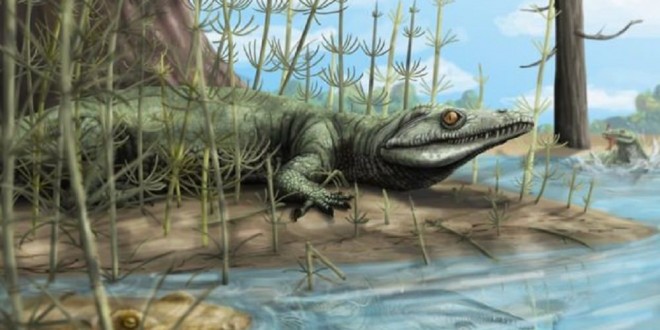A newly discovered 250-million-year-old fossil reptile from Brazil gives an “extraordinary” insight into life just before the dinosaurs appeared.
Experts from the University of Birmingham and the Universidade Federal do Pampa (Unipampa) have discovered a new fossilized reptile species that would have lived approximately 250 million years ago, shortly after a mass extinction event that wiped out 90 percent of all life on Earth.
The fossil was discovered in the beginning of 2015 by a team from the Paleobiology Laboratory of the Universidade Federal do Pampa (Unipampa), in a Triassic rock exposure near the city of São Francisco de Assis. This discovery, published today in the journal Scientific Reports (Nature Publishing Group), helps to clarify the initial evolution of the group that gave rise to dinosaurs, pterosaurs (flying reptiles), crocodiles and birds.
The name Teyujagua comes from the language of the Guarani ethnic group and means ‘fierce lizard’. It references a mythological beast called Teyú Yaguá, usually depicted as a lizard with a dog´s head. Teyujagua is very different from other fossils from the same age. Its anatomy is intermediate between the more primitive reptiles and a diverse and important group called ‘archosauriforms’. Archosauriformes include all the extinct dinosaurs and pterosaurs, along with modern day birds and crocodiles.
The discovery of Teyujagua is important because it lived just after the great Permo-Triassic mass extinction event that occurred 252 million years ago. This extinction wiped out about 90 per cent of all species then living and was probably triggered by giant and intense volcanic eruptions in the eastern part of what is now Russia.
Teyujagua provides new insights into how ecosystems on land recovered and developed following this extinction. After the extinction, ecosystems on land were sparsely populated, providing opportunities for some groups of survivors to expand in number and diversity. Archosauriforms and their close kin like Teyujagua became the dominant animals in ecosystems on land and eventually gave rise to dinosaurs.
Teyujagua was a small, quadrupedal animal, and grew up to about 1.5 metres in length. Its teeth were recurved with fine serrations and sharply pointed, indicating a carnivorous diet. The nostrils were placed on the upper part of the snout, a typical feature of some aquatic or semi-aquatic animals, such as modern day crocodiles. Teyujagua likely lived in the margins of lakes and rivers, hunting amphibians and procolophonids, extinct, small bodied reptiles similar to lizards.
Dr Felipe Pinheiro, from Universidade Federal do Pampa, São Gabriel, Rio Grande do Sul said:
‘The discovery of Teyujagua was really exciting. Ever since we saw that beautiful skull for the first time in the field, still mostly covered by rock, we knew we had something extraordinary in our hands. Back in the lab, after slowly exposing the bones, the fossil exceeded our expectations. It had a combination of features never seen before, indicating the unique position of Teyujagua in the evolutionary tree of an important group of vertebrates.’
Dr Richard Butler, from the University of Birmingham’s School of Geography, Earth and Environmental Sciences, said:
‘Teyujagua is a really important discovery because it helps us understand the origins of a group of vertebrates called archosauriforms. Archosauriforms are spectacularly diverse and include everything from hummingbirds and crocodiles to giant dinosaurs like Tyrannosaurus rex and Brachiosaurus. Teyujagua fills an evolutionary gap between archosauriforms and more primitive reptiles and helps us understand how the archosauriform skull first evolved.’
Excavations in the site where Teyujagua was found are still ongoing, with more promising fossil materials being found. These new discoveries will certainly provide new insights into the nature of terrestrial ecosystems just before the appearance of the first dinosaurs, as well as the patterns of faunal recovery after major extinction events.
Agencies/Canadajournal
 Canada Journal – News of the World Articles and videos to bring you the biggest Canadian news stories from across the country every day
Canada Journal – News of the World Articles and videos to bring you the biggest Canadian news stories from across the country every day




That’s pretty cool! Can’t wait to see if they find others in the same rock layer.